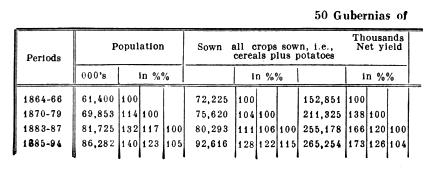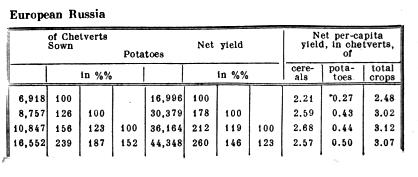
Russia[6]
Having examined the internal economic structure of peasant and landlord economy, we must now take up the question of the changes in agricultural production and ask: do these changes express a growth of capitalism and of the home market?
Let us glance first of all at the general statistics on grain production in European Russia. The considerable harvest fluctuations render the data for individual periods or for individual years quite useless.[1] It is necessary to take different periods and the data for a whole number of years. We have at our disposal the following data: for the period of the 60s, the data for 1864-1866 (Military Statistical Abstract, IV, St. Petersburg, 1871, data of gubernatorial reports). For the 70s, the returns of the Department of Agriculture for the entire decade (Historico-Statistical Survey of Russian Industry, Vol. I, St. Petersburg, 1883). And lastly, for the 1880s, we have data for the five years of 1883-1887 (Statistics of the Russian Empire, IV); this five-year period can represent the whole of the eighties, since the average harvest for the ten years, 1880-1889, is even somewhat higher than for the five years 1883-1887 (see Agriculture and Forestry in Russia, published for the Chicago Exhibition, pp. 132 and 142). Further, in order to judge of the trend of evolution in the 90s we take the data for the decade 1885-1894 (Productive Forces, I, 4). Lastly, the data for 1905 (Yearbook of Russia, 1906) are quite adequate for a judgement of the present time. The 1905 harvest was only a little lower than the average for the five years 1900-1904.
Let us compare all these data.[2]

Russia[6]
We see from this that until the 1890s the post-Reform era is characterised by an undoubted increase in the production both of cereals and potatoes. The productivity of agricultural labour rises: firstly, the size of the net yield grows faster than that of the sown area (with occasional exceptions); secondly, we must bear in mind that the proportion of the population engaged in agricultural production steadily diminished during this period owing to the diversion of the population from agriculture to commerce and industry, and also owing to the migration of peasants beyond the bounds of European Russia.[3] What is particularly noteworthy is the fact that it is commercial agriculture that is growing: there is an increase in the amount of grain gathered (after subtracting seed) per head of the population, while among this population there is an ever-growing division of social labour; there is an increase in the commercial and industrial population; the agricultural population splits up into rural entrepreneurs and a rural proletariat; there is an extension of specialisation in agriculture itself, so that the amount of grain produced for sale grows far more rapidly than the total amount of grain produced in the country. The capitalist character of the process is strikingly illustrated by the increased share of potatoes in the total agricultural production.[4] The increase in the area under potatoes signifies, on the one hand, an improvement in agricultural technique (the introduction of root-crops) and increased technical processing of agricultural produce (distilling and the manufacture of potato starch). On the other hand, it is, from the viewpoint of the rural entrepreneur class, the production of relative surplus-value (cheapening of the cost of maintaining labour-power, deterioration of the people’s nourishment). The data for the decade 1885-1894 show further that the crisis of 1891-1892, which tremendously intensified the expropriation of the peasantry, led to a considerable reduction in the output of cereals and to a reduction in the yield of all crops; but the process of the displacement of cereals by potatoes continued with such force that the per-capita output of potatoes increased, not withstanding the reduced yield. Finally, the last five years (1900-1904) also show an increase in agricultural production, an increase in the productivity of agricultural labour and a worsening of the conditions of the working-class (increase in the part played by potatoes).
As we have noted above, the growth of commercial agriculture manifests itself in the specialisation of agriculture. Mass-scale and gross data on the production of all crops can give (and then not always) only the most general indications of this process, since the specific features of the different areas thereby disappear. Yet it is precisely the segregation of the different agricultural areas that is one of the most characteristic features of post-Reform agriculture in Russia. Thus, the Historico-Statistical Survey of Russian Industry (Vol. I, St. Petersburg, 1883), quoted by us, enumerates the following agricultural areas: the flax area, “the region where stock farming predominates,” and where, in particular, “dairy farming is considerably developed”; the region where grain crops predominate, particularly the three-field area and the area with the improved fallow or multi-field grass system (part of the steppe belt, which “is characterised by the production of the most valuable, so-called elite grains, mainly intended for the foreign market”); the beet area, and the area in which potatoes are cultivated for distilling purposes. “The economic areas indicated have arisen in European Russia comparatively recently, and with every passing year continue increasingly to develop and become more segregated” (loc. cit., p. 15).[5] Our task should now be, consequently, to study this process of the specialisation of agriculture, and we should ascertain whether a growth of commercial agriculture is to be observed in its various forms, whether capitalist agriculture comes into existence in the process, and whether agricultural capitalism bears the features we indicated above in analysing the general data on peasant and landlord farming. It goes without saying that for our purposes it will be sufficient if we confine ourselves to describing the principal areas of commercial agriculture.
But before examining the data for the separate areas, let us note the following: the Narodnik economists, as we have seen, do all they can to evade the fact that the characteristic feature of the post-Reform period is the growth of commercial agriculture. Naturally, in doing so they also ignore the circumstance that the drop in grain prices is bound to stimulate the specialisation of agriculture and the drawing of agricultural produce into the sphere of exchange. Here is an instance. The authors of the well-known book The Influence of Harvests and Grain Prices all proceed from the postulate that the price of grain is of no importance to natural economy, and they repeat this “truism” endlessly. One of them, Mr. Kablukov, has observed, however, that under the general conditions of commodity production this postulate is substantially wrong. “It is possible, of course,” he writes, “that the grain placed on the market has cost less to produce than that grown on the consumer’s farm, in which case it would appear to be in the interest also of the consuming farm to change from cultivating cereals to other crops” (or to other occupations, we would add), “and, consequently, for it too the market price of grain assumes importance as soon as it fails to coincide with its cost of production” (I, 98, note, author’s italics). “But we cannot take that into account,” he says peremptorily. Why is that? Because, it seems: 1) a change-over to other crops is possible “only where certain conditions exist.” By means of this empty truism (everything on earth is possible only under certain conditions!) Mr. Kablukov calmly evades the fact that the post-Reform period in Russia has created, and continues to create, the very conditions that call for the specialisation of agriculture and the diversion of the population from agriculture. . . . 2) Because “in our climate it is impossible to find a crop equal to cereals in food value”. The argument is highly original, expressing a mere evasion of the issue. What has the food value of other crops to do with the matter, if we are dealing with the sale of these other crops and the purchase of cheap grain? . . . 3) Because “grain farms of the consuming type always have a rational basis for their existence.” In other words, because Mr. Kablukov “and colleagues” regard natural economy as “rational.” The argument, as you see, is irrefutable. . . .
[1] If only for this reason, Mr. N.–on is absolutely wrong in drawing the boldest conclusions from the returns for 8 years of one decade (1871-1878)!—Lenin
[2] For the period 1883-1887 we have taken the population of 1885; the increase is taken at 1.2%. The difference between the data of the gubernatorial reports and those of the Department of Agriculture is, as we know, inconsiderable. The figures for 1905 have been arrived at by converting poods into chetverts (about six bushels each.—Ed.)—Lenin
[3] Mr. N.–on is quite wrong when he asserts that “there are no grounds whatever for assuming a decline in their number” (the number of persons engaged in agricultural production), “quite the contrary” (Sketches, 33, note). See Chapter VIII, § II.—Lenin
[4] The net per-capita potato crop increased between 1864-1866 and 1870-1879 in all areas of European Russia without exception. Between 1870-1879 and 1883-1887 the increase took place in 7 areas out of 11 (the Baltic, Western, Industrial, North-Western, Northern, Southern, Steppe, Lower- and Transvolga areas).
Cf. Agricultural Statistical Information Based on Material Obtained from Farmers, Vol. VII, St. Petersburg, 1897 (published by Ministry of Agriculture).[7] In 1871, in the 50 gubernias of European Russia, the area under potatoes was 790,000 dess. in 1881—1,375,000 dess. and in 1895—2,154,000 dess, i.e., an increase during the 15 years of 55% . Taking the potato crop in 1841 as 100, we get the following figures for the later years: 1861—120; 1871—162; 1881—297; 1895—530.—Lenin
[5] Cf. also Agriculture and Forestry in Russia, pp. 84-88; here a tobacco area is added. The maps drawn by Messrs. D. Semyonov and A. Fortunatov show the areas according to the particular crops predominating in them; for example the rye, oat and flax area, Pskov and Yaroslavl gubernias; the rye, oat and potato area, Grodno and Moscow gubernias, and so on.—Lenin
[6] In the first edition (1899) of The Development of Capitalism in Russia the table was given as follows:


[7] Lenin’s notes on this publication and his preliminary calculations are published in Lenin Miscellany XXXIII, pp. 165-175.
| | |
| | | | | | |